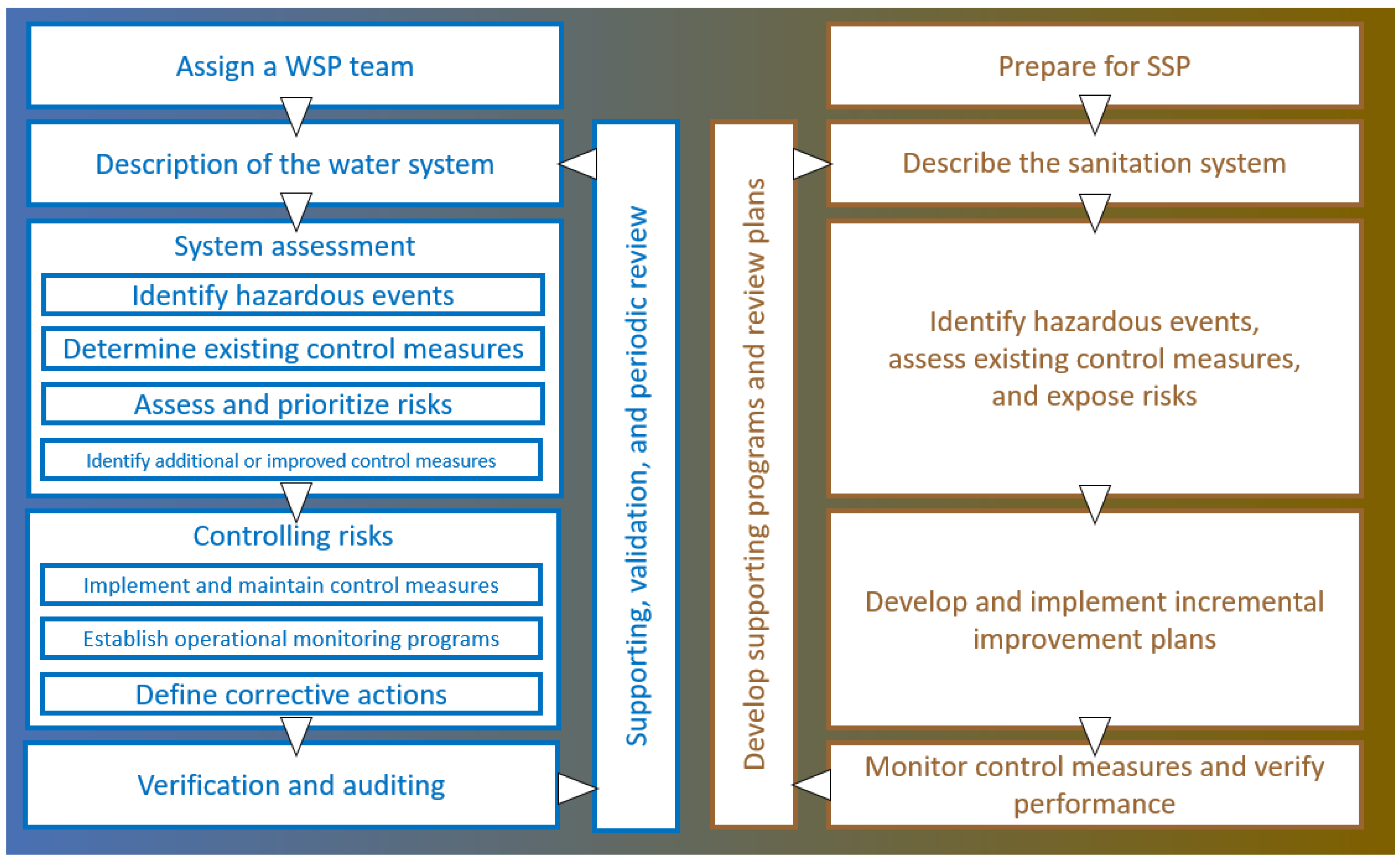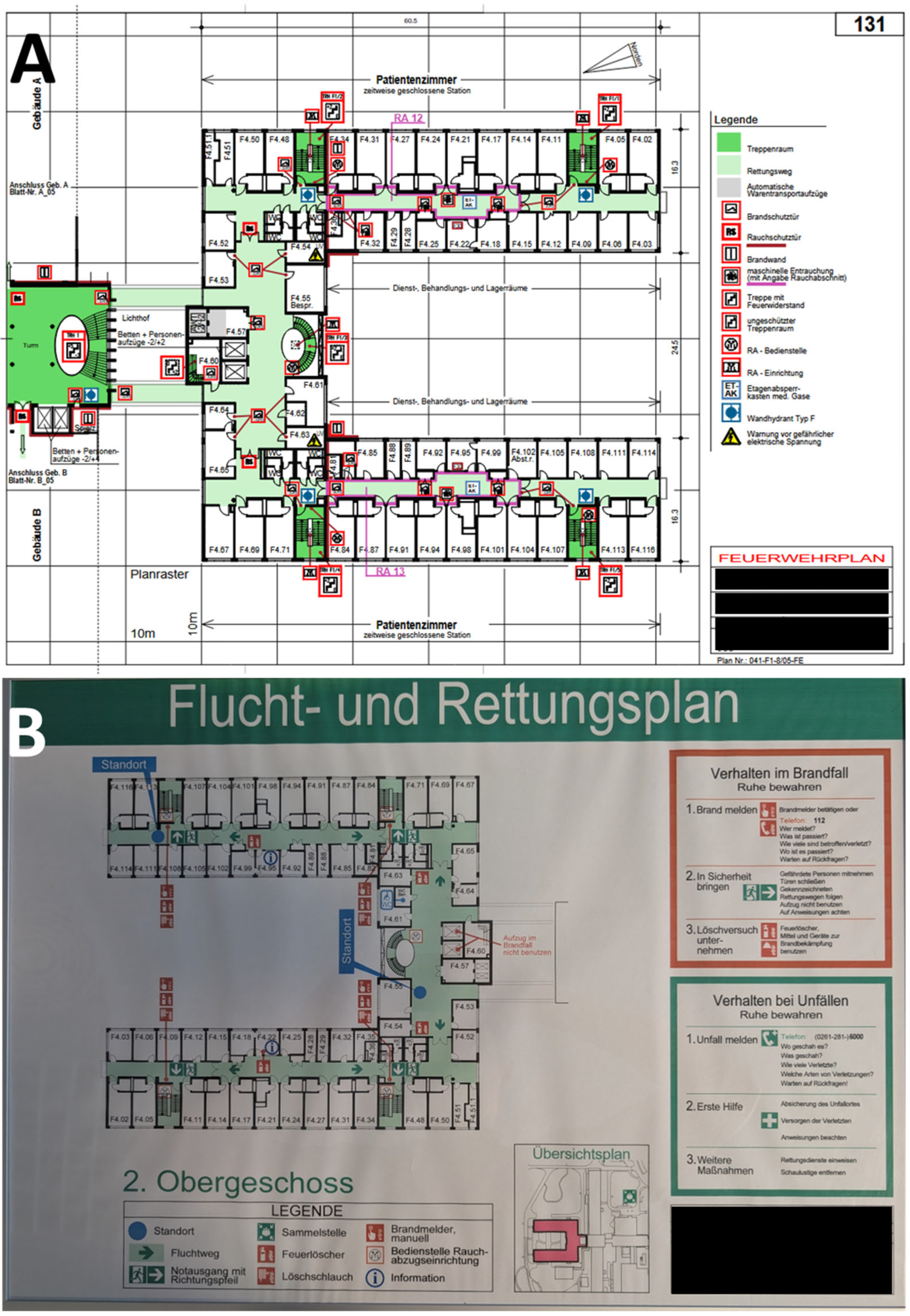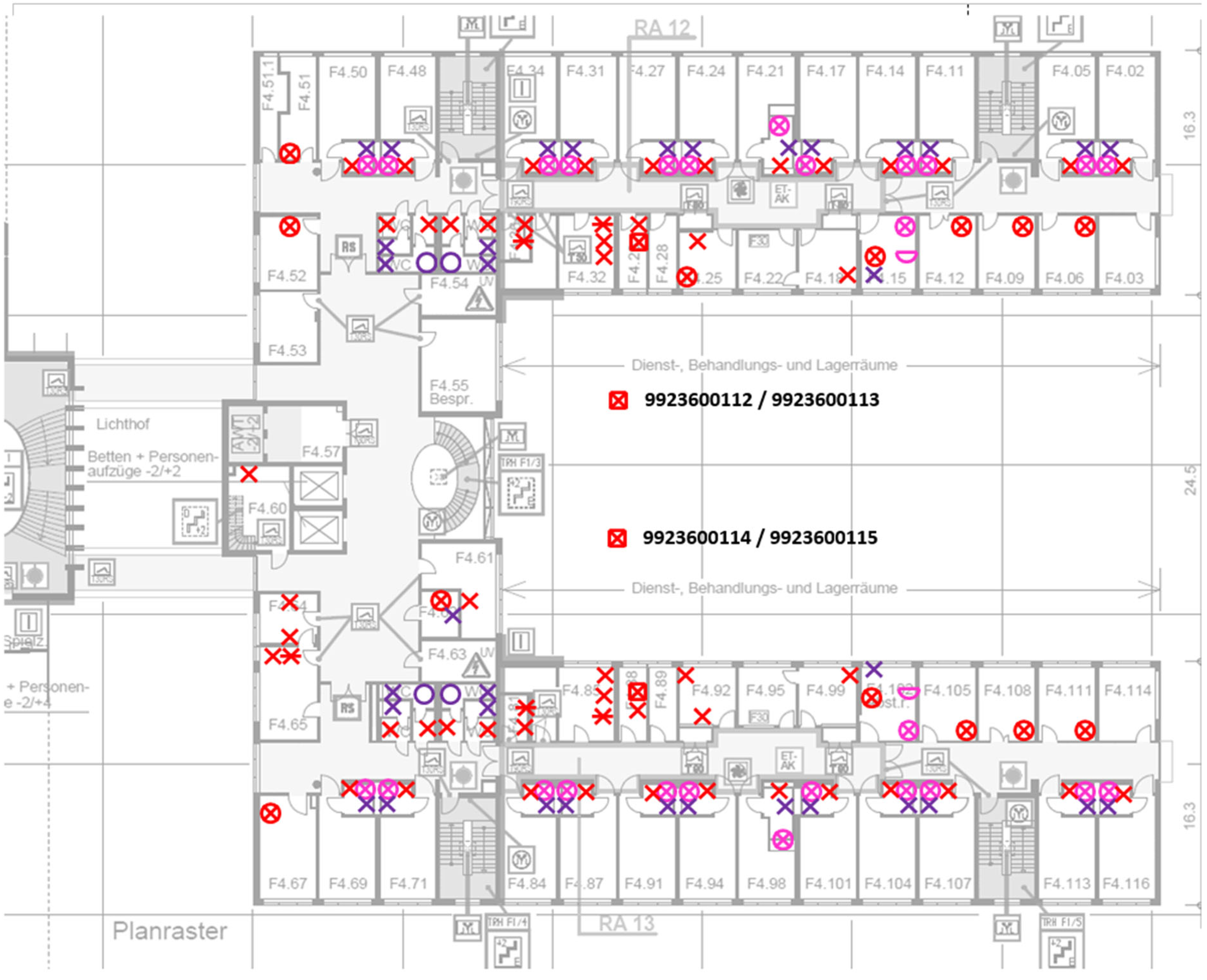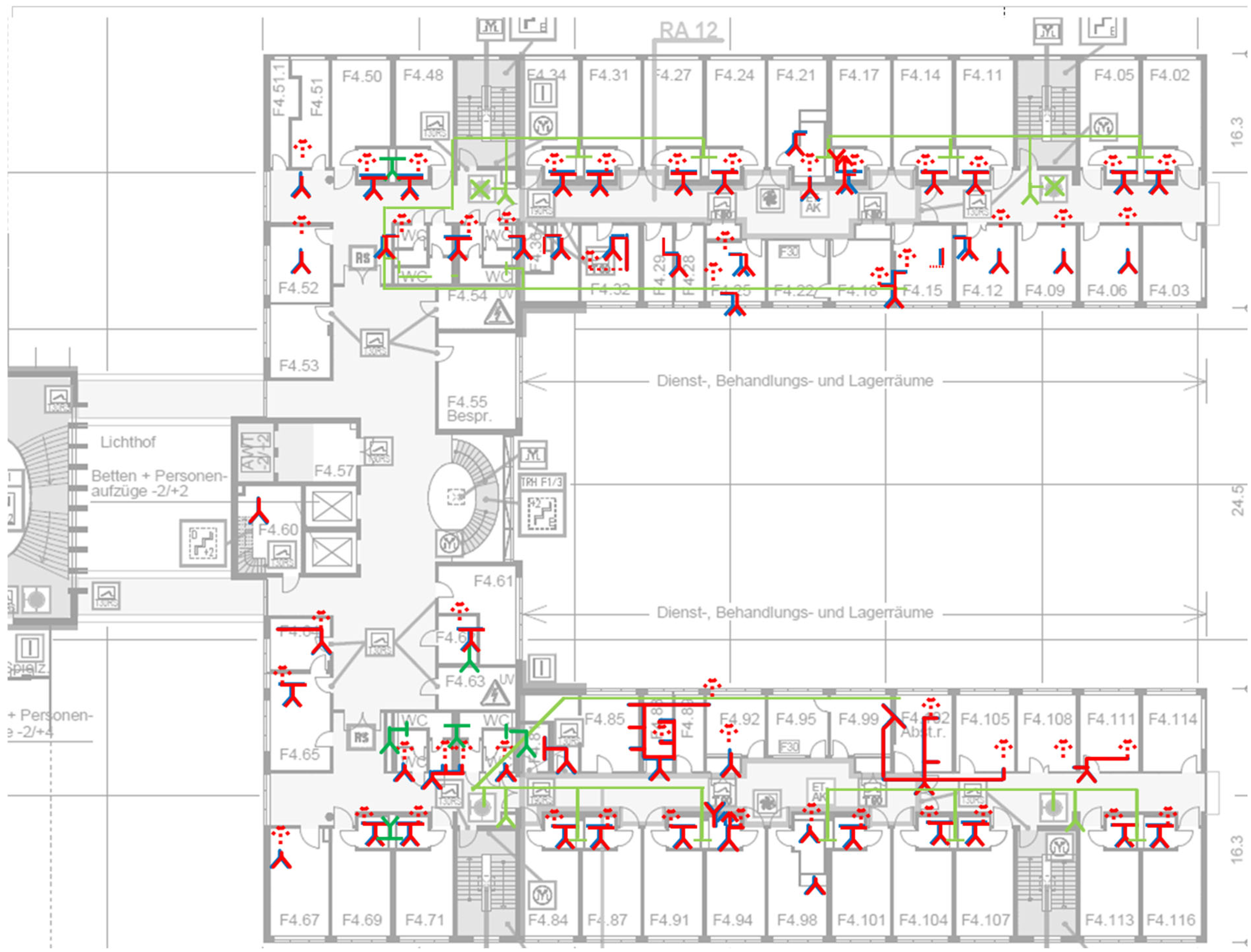Drinking Water and Sanitation Safety Planning for Medical Facilities: An Innovative PoU Approach for a Water System Description Using Ecomaps
Abstract
1. Introduction
- “document all components of the building water systems, including PoE and PoU treatment, distribution systems (e.g., hot water, cold water, firefighting), water-using devices (e.g., swimming pools, cooling towers) and specific water uses”;
- “[identify] the uses of each type of water”;
- “follow the delivery of water from PoE to all points of delivery or use within the building” [11].
2. Materials and Methods
2.1. Premises
- The system description should include all essential parts of the drinking water installation;
- The system description should be possible with the usual equipment (no—expensive—software or hardware);
- The system description should be carried out with the least possible additional personnel costs;
- The system description should be controllable, versionable, changeable, and forgery-proof;
- all PoU in rooms in which patients or non-technical staff are regularly present;
- all PoU water systems that communicate directly or indirectly with the drinking water installation;
- all cold and warm water pipes as well as sewage pipes and pipes for other types of water, if appropriate.
2.2. On-Site Inspection
2.2.1. Plans
- They must be prepared by a suitably qualified person.
- They must be reviewed and updated every two years.
- They must be based on a 10 × 10-m grid.
- They must be printable on A3- or A4-sized paper [25].
2.2.2. Pens
2.2.3. Coding System
- Be logical and unambiguous;
- Be simple and as self-explanatory as possible;
- Be presentable with simple symbols;
- Be presentable both with and without electronic IT tools;
- Be designed in such a way that it can be adapted and expanded;
- Enable a presentation of the most important information that is appropriate;
- Be suitable as a basis for cooperation within and between medical facilities.
2.2.4. Attachment Sheets
2.3. Transfer into Digital Ecomaps
2.3.1. Possible Extension Using a Schematic Pipe Diagram
2.3.2. PDF Generation
2.4. Updates
3. Results
4. Discussion
4.1. Hazards from Drinking Water
4.2. Advantages of the PoU Approach
4.3. Hazards from Sewage
4.4. Embedding in Environmental, Occupational Safety, and Quality Management
4.5. Water Security and Emergency Preparedness
4.6. The Global Context
5. Conclusions
Supplementary Materials
Author Contributions
Funding
Data Availability Statement
Conflicts of Interest
Abbreviations
| DWSP | Drinking Water Safety Plan |
| EMAS | Eco-Management and Audit Scheme |
| ISO | International Organization for Standardization |
| PoE | Point of Entry |
| PoU | Point of Use |
| PWC | Potable Water Cold |
| PWH | Potable Water Hot |
| PWH-C | Potable Water Hot—Circulation |
| SDG | Sustainable Development Goals |
| SSP | Sanitation Safety Plan |
| WHO | World Health Organization |
| WSP | Water Safety Plan |
References
- United Nations General Assembly. The Human Right to Water and Sanitation: Resolution 64/292; United Nations General Assembly: New York, NY, USA, 2010. [Google Scholar]
- DIN 2000; Zentrale Trinkwasserversorgung-Leitsätze für Anforderungen an Trinkwasser, Planung, Bau, Betrieb und Instandhaltung der Versorgungsanlagen. Deutsches Institut für Normung: Berlin, Germany, 2017.
- United Nations General Assembly. Transforming Our World: The 2030 Agenda for Sustainable Development: Resolution 70/1; United Nations General Assembly: New York, NY, USA, 2015. [Google Scholar]
- United Nations (UN). Ensure healthy lives and promote well-being for all at all ages. In Goals; CRC Press: Boca Raton, FL, USA, 2020. [Google Scholar]
- United Nations (UN). Ensure availability and sustainable management of water and sanitation for all. In Goals; CRC Press: Boca Raton, FL, USA, 2020. [Google Scholar]
- United Nations (UN). The Sustainable Development Goals Report 2024; United Nations: New York, NY, USA, 2024. [Google Scholar]
- World Health Organization (WHO). Guidelines for Drinking-Water Quality, 1st ed.; World Health Organization (WHO): Geneva, Switzerland, 1978.
- World Health Organization (WHO). Guidelines for Drinking-Water Quality, 3rd ed.; World Health Organization (WHO): Geneva, Switzerland, 2004.
- World Health Organization (WHO). Sanitation Safety Planning: Step-By-Step Risk Management for Safely Managed Sanitation Systems, 2nd ed.; World Health Organization: Geneva, Switzerland, 2022.
- World Health Organization (WHO). Guidelines for Drinking-Water Quality: Incorporating the First and Second Addenda, 4th ed.; World Health Organization: Geneva, Switzerland, 2022.
- World Health Organization (WHO). Water Safety in Buildings; World Health Organization: Geneva, Switzerland, 2011.
- Schmidt, I.; Rickert, B.; Schmoll, O.; Rapp, T. Implementation and evaluation of the water safety plan approach for buildings. J. Water Health 2019, 17, 870–883. [Google Scholar] [CrossRef]
- Krause, S.; Joel, E.; Schaum, C.; Bäumer, J.; Rücker, N.; Wienand, I.; Sturm, C.; Jahn-Mühl, B.; Geiger, M.; Fekete, A.; et al. Water safety planning for healthcare facilities for extreme events. J. Water Health 2024, 22, 77–96. [Google Scholar] [CrossRef]
- Dyck, A. Experimental Based Experiences with the Introduction of a Water Safety Plan for a Multi-Located University Clinic and Its Efficacy According to WHO Recommendations. M.D. Dissertation, University of Greifswald, Greifswald, Germany, 2007. Available online: https://epub.ub.uni-greifswald.de/frontdoor/deliver/index/docId/354/file/Dissertation_A_Dyck.pdf (accessed on 22 June 2025).
- Dyck, A.; Exner, M.; Kramer, A. Experimental based experiences with the introduction of a water safety plan for a multi-located university clinic and its efficacy according to WHO recommendations. BMC Public Health 2007, 7, 34. [Google Scholar] [CrossRef]
- Exner, M.; Döhla, M.; Schmithausen, R.M.; Pleischl, S.; Koch, C.; Exner, D. Hygienisch-mikrobiologische Risiken sowie Präventions- und Kontrollstrategien in der Trinkwasserversorgung und Abwasserentsorgung im Krankenhaus. Hyg. Med. 2020, 45, D1–D12. [Google Scholar]
- European Commission: Directorate-General for Environment. EMAS “Easy” for Small and Medium Enterprises–In 10 Days, with 10 People, on 10 Pages, in 30 Steps. 2007. Available online: https://op.europa.eu/en/publication-detail/-/publication/a46da1ae-edee-47aa-b871-d13baa946379/language-en (accessed on 22 June 2025).
- DIN EN ISO 9001; Quality Management Systems–Requirements (ISO 9001:2015): German and English Version EN ISO 9001:2015. Beuth: Berlin, Germany, 2015.
- World Health Organization (WHO). A Field Guide to Improving Small Drinking-Water Supplies: Water Safety Planning for Rural Communities; World Health Organization: Geneva, Switzerland, 2022.
- Rapp, T.; Rickert, B.; Schmidt, I.; Schmoll, O.; Zügner, V. Das Water Safety Plan (WSP)-Konzept für Gebäude: Ein Handbuch für Die Anwendung in Trinkwasser-Installationen; Umweltbundesamt: Dessau-Roßlau, Germany, 2020. [Google Scholar]
- Schmoll, O.; Bethmann, D.; Sturm, S.; Schnabel, B. Das Water-Safety-Plan-Konzept: Ein Handbuch für kleine Wasserversorgungen, 3rd ed.; Umweltbundesamt: Dessau-Roßlau, Germany, 2018. [Google Scholar]
- Döhla, M. Organisation und Taktiken des Wasserrettungsdienstes: Beitrag zu einer „Dienstvorschrift 3“ für Wasserretter (WR-DV 3); Verlagsgesellschaft Stumpf + Kossendey mbH: Edewecht, Germany, 2023. [Google Scholar]
- Górska, R.A. European Standards for Construction Drawings. J. Pol. Soc. Geom. Eng. Graph. 2011, 22, 31–42. Available online: http://ogigi.polsl.pl/biuletyny/zeszyt_22/biuletyn-22-p31-42.pdf (accessed on 22 June 2025).
- ISO 4157; Construction Drawings—Designation Systems: Part 1: Buildings and Parts of Buildings. ISO: Geneva, Switzerland, 1998.
- DIN EN ISO 216; Writing Paper and Certain Classes of Printed Matter–Trimmed Sizes–A and B Series, and Indication of Machine Direction (ISO 216:2007): German version EN ISO 216:2007. Beuth: Berlin, Germany, 2007.
- DIN 14095; Ground Plans for Components for Buildings for Fire Brigade Use. Beuth: Berlin, Germany, 2024.
- ISO 23601; Safety Identification-Escape and Evacuation Plan Signs. ISO: Geneva, Switzerland, 2009.
- Bundesamt für Bevölkerungsschutz und Katastrophenhilfe (BBK). Taktische Zeichen im Bevölkerungsschutz: Empfehlungen zur Einführung Einer FwDV 102/DV 102; Bundesamt für Bevölkerungsschutz und Katastrophenhilfe (BBK): Bonn, Germany, 2024. [Google Scholar]
- The Scribus Team. Scribus Project: The Official Scribus GitHub Repository. 2025. Available online: https://github.com/scribusproject (accessed on 22 June 2025).
- DIN EN ISO 31000; Risk Management-Guidelines (ISO 31000:2018). DIN Media: Berlin, Germany, 2018.
- Decker, B.K.; Palmore, T.N. Hospital water and opportunities for infection prevention. Curr. Infect. Dis. Rep. 2014, 16, 432. [Google Scholar] [CrossRef] [PubMed]
- Spagnolo, A.M.; Cristina, M.L.; Casini, B.; Perdelli, F. Legionella pneumophila in healthcare facilities. Rev. Med. Microbiol. 2013, 24, 70–80. [Google Scholar] [CrossRef]
- Turban, A.; Morin-Le Bihan, A.; Derbier, L.; Piau-Couapel, C.; Nesseler, N.; Cattoir, V.; Donnio, P.Y.; Ménard, G. Effectiveness of water system chemical disinfection against Pseudomonas aeruginosa infections, despite a not-so-obvious connection. Am. J. Infect. Control. 2024, 52, 1432–1437. [Google Scholar] [CrossRef]
- Exner, M.; Nissing, W.; Behringer, K.; Engelhart, S.; Pleischl, S.; Koch, C.; Trautmann, M.; Kramer, A.; Walger, P.; Martiny, H.; et al. Gesundheitliche Bedeutung, Prävention und Kontrolle Wasser-assoziierter Pseudomonas aeruginosa-Infektionen. Hyg. Med. 2016, 41 (Suppl. 2), 2–32. [Google Scholar]
- Witzisk, P. Pseudomonas aeruginosa als Kontaminant der Trinkwasserinstallation einer Chirurgischen OP-Einheit: Hygienische Intervention und Präventionsansätze. M.D. Dissertation, Rheinische Friedrich-Wilhelms-Universität Bonn, Bonn, Germany, 2023. [Google Scholar]
- Ficheux, A.; Réthoret, J.; Laget, J.; Baux, C.; Gayrard, N.; Duranton, F.; Vetromile, F.; Szwarc, I.; Cazevieille, C.; Servel, M.-F.; et al. Successful Disinfection of a New Healthcare Facility Contaminated with Pseudomonas aeruginosa. Hygiene 2022, 2, 1–13. [Google Scholar] [CrossRef]
- Loveday, H.P.; Wilson, J.A.; Kerr, K.; Pitchers, R.; Walker, J.T.; Browne, J. Association between healthcare water systems and Pseudomonas aeruginosa infections: A rapid systematic review. J. Hosp. Infect. 2014, 86, 7–15. [Google Scholar] [CrossRef] [PubMed]
- Hayward, C.; Ross, K.E.; Brown, M.H.; Bentham, R.; Hinds, J.; Whiley, H. Drinking water plumbing systems are a hot spot for antimicrobial-resistant pathogens. J. Hosp. Infect. 2025, 159, 62–70. [Google Scholar] [CrossRef]
- Yui, S.; Karia, K.; Ali, S. Evaluation of novel disinfection methods for the remediation of heavily contaminated thermostatic mixing valves and water systems with Pseudomonas aeruginosa biofilm: Considerations for new and existing healthcare water systems. J. Hosp. Infect. 2024, 151, 195–200. [Google Scholar] [CrossRef] [PubMed]
- Elgoulli, M.; Zahir, H.; Ellouali, M.; Latrache, H. Chlorination of Pseudomonas aeruginosa in potable water. Int. J. Environ. Health Res. 2024, 34, 4110–4117. [Google Scholar] [CrossRef]
- Behrends, H.-B. Pseudomonaden in einem Klinikneubau. Gesundheitswesen (Bundesverb. Arzte Offentlichen Gesundheitsdienstes (Ger.)) 2003, 65, 736–737. [Google Scholar] [CrossRef]
- Gavaldà, L.; Garcia-Nuñez, M.; Quero, S.; Gutierrez-Milla, C.; Sabrià, M. Role of hot water temperature and water system use on Legionella control in a tertiary hospital: An 8-year longitudinal study. Water Res. 2019, 149, 460–466. [Google Scholar] [CrossRef]
- LeChevallier, M.W.; Prosser, T.; Stevens, M. Opportunistic Pathogens in Drinking Water Distribution Systems—A Review. Microorganisms 2024, 12, 916. [Google Scholar] [CrossRef]
- Kistemann, T.; Schulte, W.; Rudat, K.; Hentschel, W.; Häußermann, D. Gebäudetechnik für Trinkwasser: Fachgerecht Planen-Rechtssicher Ausschreiben-Nachhaltig Sanieren, 2nd ed.; VDI-Buch; Springer: Berlin/Heidelberg, Germany, 2017. [Google Scholar]
- Unterberg, M.; Rahmel, T.; Kissinger, T.; Petermichl, C.; Bosmanns, M.; Niebius, M.; Schulze, C.; Jochum, H.-P.; Parohls, N.; Adamzik, M.; et al. Legionella contamination of a cold-water supplying system in a German university hospital-assessment of the superheat and flush method for disinfection. J. Prev. Med. Hyg. 2021, 62, E751–E758. [Google Scholar] [CrossRef]
- World Health Organization (WHO). Guidelines for Drinking-Water Quality, 4th ed.; World Health Organization (WHO): Geneva, Switzerland, 2011.
- World Health Organization (WHO). Water Safety Planning for Small Community Water Supplies: Step-By-Step Risk Management Guidance for Drinking-Water Supplies in Small Communities; World Health Organization: Geneva, Switzerland, 2012.
- World Health Organization (WHO). A Practical Guide to Auditing Water Safety Plans; World Health Organization: Geneva, Switzerland, 2015.
- Döhla, M.; Jaensch, A.; Döhla, C.; Voigt, A.; Exner, M.; Färber, H. Lead in drinking water-an old problem, a new EU directive. Bundesgesundheitsblatt Gesundheitsforschung Gesundheitsschutz 2021, 64, 501–508. [Google Scholar] [CrossRef]
- Jarvis, P.; Fawell, J. Lead in drinking water–An ongoing public health concern? Curr. Opin. Environ. Sci. Health 2021, 20, 100239. [Google Scholar] [CrossRef]
- Lytle, D.A.; Schock, M.R. Impact of stagnation time on metal dissolution from plumbing materials in drinking water. J. Water Supply Res. Technol.-AQUA 2000, 49, 243–257. [Google Scholar] [CrossRef]
- Gamage, S.D.; Ambrose, M.; Kralovic, S.M.; Roselle, G.A. Water Safety and Legionella in Health Care: Priorities, Policy, and Practice. Infect. Dis. Clin. N. Am. 2016, 30, 689–712. [Google Scholar] [CrossRef]
- Völker, S.; Luther, S.; Kistemann, T. Bundesweite Statusanalyse: Vorkommen von Legionellen in Trinkwasser-Installationen: Studie Wertet über 1 Mio. Probenahmen-Ergebnisse Aus; IKZ-Fachplaner: Arnsberg, Germany, 2015; pp. 14–19. Available online: https://www.water-control.de/wp-content/uploads/2023/03/Sonderdruck-Bundesweite-Statusanalyse.pdf (accessed on 22 June 2025).
- Becker, W.; Luther, S. Legionellen im Trinkwasser: Überwachungspraxis im Gesundheitsamt; Media SuUB: Bremen, Germany, 2018. [Google Scholar]
- World Health Organization (WHO). Water Safety Plan Manual: Step-By-Step Risk Management for Drinking-Water Suppliers, 2nd ed.; World Health Organization: Geneva, Switzerland, 2023.
- Čretnik, A.; Pfeifer, R. 5. Prehospital management. Eur. J. Trauma Emerg. Surg. Off. Publ. Eur. Trauma Soc. 2025, 51, 198. [Google Scholar] [CrossRef]
- Macioszek, E. First and Last Mile Delivery–Problems and Issues. In Advanced Solutions of Transport Systems for Growing Mobility, Proceedings of the 14th Scientific and Technical Conference Transport Systems, Katowice, Poland, 18–20 September 2017; Sierpiński, G., Ed.; Theory & Practice 2017 Selected Papers. Advances in Intelligent Systems and Computing Ser. v.631; Springer International Publishing: Cham, Germany, 2017; pp. 147–154. [Google Scholar]
- The.Wave.Talk. Solving The Last Mile Problem in Water Quality; The.Wave.Talk: Seoul, Republic of Korea, 2024. [Google Scholar]
- Umweltbundesamt (UBA). Drinking Water: It’s the Last Metres That Count! Umweltbundesamt (UBA): Dessau-Roßlau, Germany, 2012. [Google Scholar]
- Blume, S.; Nordmann, D.; Schäfer, D.; Werchota, R. Closing the Last Mile for Millions: Sharing the Experience on Scaling Up Access to Safe Drinking Water and Adequate Sanitation to the Urban Poor; Deutsche Gesellschaft für Internationale Zusammenarbeit (GIZ) GmbH: Bonn, Germany, 2015. [Google Scholar]
- Korzybski, A. Science and Sanity: An Introduction to Non-Aristotelian Systems and General Semantics; International Non-Aristotelian Library Publishing Company: San Francisco, CA, USA, 1933. [Google Scholar]
- Sib, E.; Voigt, A.M.; Wilbring, G.; Schreiber, C.; Faerber, H.A.; Skutlarek, D.; Parcina, M.; Mahn, R.; Wolfc, D.; Brossart, P.; et al. Antibiotic resistant bacteria and resistance genes in biofilms in clinical wastewater networks. Int. J. Hyg. Environ. Health 2019, 222, 655–662. [Google Scholar] [CrossRef]
- Voigt, A.M.; Zacharias, N.; Timm, C.; Wasser, F.; Sib, E.; Skutlarek, D.; Parcina, M.; Schmithausen, R.M.; Schwartz, T.; Hembach, N.; et al. Association between antibiotic residues, antibiotic resistant bacteria and antibiotic resistance genes in anthropogenic wastewater–An evaluation of clinical influences. Chemosphere 2020, 241, 125032. [Google Scholar] [CrossRef]
- Müller, H.; Sib, E.; Gajdiss, M.; Klanke, U.; Lenz-Plet, F.; Barabasch, V.; Albert, C.; Schallenberg, A.; Timm, C.; Zacharias, N.; et al. Dissemination of multi-resistant Gram-negative bacteria into German wastewater and surface waters. FEMS Microbiol. Ecol. 2018, 94, fiy057. [Google Scholar] [CrossRef]
- Neidhöfer, C.; Sib, E.; Neuenhoff, M.; Schwengers, O.; Dummin, T.; Buechler, C.; Klein, N.; Balks, J.; Axtmann, K.; Schwab, K.; et al. Hospital sanitary facilities on wards with high antibiotic exposure play an important role in maintaining a reservoir of resistant pathogens, even over many years. Antimicrob. Resist. Infect. Control 2023, 12, 33. [Google Scholar] [CrossRef]
- Neidhöfer, C.; Sib, E.; Benhsain, A.-H.; Mutschnik-Raab, C.; Schwabe, A.; Wollkopf, A.; Wetzig, N.; Sieber, M.A.; Thiele, R.; Döhla, M.; et al. Examining Different Analysis Protocols Targeting Hospital Sanitary Facility Microbiomes. Microorganisms 2023, 11, 185. [Google Scholar] [CrossRef] [PubMed]
- Mahmood, H.Y.; Jamshidi, S.; Sutton, J.M.; Rahman, K.M. Current Advances in Developing Inhibitors of Bacterial Multidrug Efflux Pumps. Curr. Med. Chem. 2016, 23, 1062–1081. [Google Scholar] [CrossRef]
- Krul, D.; da Silva Negoseki, B.R.; Siqueira, A.C.; de Oliveira Tomaz, A.P.; Dos Santos, É.M.; de Sousa, I.; Vasconcelos, T.M.; Marinho, I.C.R.; Arend, L.N.V.S.; Mesa, D.; et al. Spread of antimicrobial-resistant clones of the ESKAPEE group: From the clinical setting to hospital effluent. Sci. Total Environ. 2025, 973, 179124. [Google Scholar] [CrossRef]
- Tamma, P.D.; Heil, E.L.; Justo, J.A.; Mathers, A.J.; Satlin, M.J.; Bonomo, R.A. Infectious Diseases Society of America 2024 Guidance on the Treatment of Antimicrobial-Resistant Gram-Negative Infections. Clin. Infect. Dis. 2023, ciae403. [Google Scholar] [CrossRef]
- Lin, C.J.; Richardson, D.B.; Hilborn, E.D.; Weinberg, H.; Engel, L.S.; Wade, T.J. Emergency Department Visits for Acute Gastrointestinal Illness After a Major Water Pipe Break in 2010. Epidemiology 2019, 30, 893–900. [Google Scholar] [CrossRef]
- Blanchard, S. Hospital Patients Are at Risk from Leaking SEWAGE and Crumbling Ceilings Because Many NHS Buildings Are in a Poor State of Repair, Report Reveals. 2019. Available online: https://www.dailymail.co.uk/health/article-7209187/The-shocking-state-hospitals-revealed.html (accessed on 22 June 2025).
- Wong, S.-C.; Yuen, L.L.H.; Chen, J.H.K.; Yuen, K.-Y.; Cheng, V.C.C. Infection control challenges in handling recurrent blockage of sewage pipes in isolation facility designated for patients with COVID-19. J. Hosp. Infect. 2021, 114, 187–189. [Google Scholar] [CrossRef]
- Leistner, B.; Rauschning, D.; Hagen, R.M.; Srečec, F.; Mutters, N.T.; Weppler, R.; Mutschnik, C.; Döhla, M. Logistic Stewardship: Supporting Antimicrobial Stewardship Programs Based on Antibiotics Goods Flow. Antibiotics 2025, 14, 43. [Google Scholar] [CrossRef] [PubMed]
- Döhla, M.; Sib, E.; Dericks, B.; Grobe, S.; Behringer, K.; Frechen, M.; Simon, K.; Färber, H.; Lenz, F.; Parcina, M.; et al. Assessment of the Prevalence of Antibiotic-Resistant Bacteria and the Concentration of Antibiotics in EU Bathing Waters in Western Germany. Expo Health 2019, 12, 323–334. [Google Scholar] [CrossRef]
- Zacharias, N.; Löckener, I.; Essert, S.M.; Sib, E.; Bierbaum, G.; Kistemann, T.; Schreiber, C. Antibiotic-Resistant Bacteria in Clams-A Study on Mussels in the River Rhine. Antibiotics 2021, 10, 571. [Google Scholar] [CrossRef]
- International Organization for Standardization (ISO); International Electrotechnical Commission (IEC). ISO/IEC Directives, Part 1: Procedures for the Technical Work—Consolidated ISO Supplement—Procedures Specific to ISO; International Organization for Standardization (ISO): Geneva, Switzerland; International Electrotechnical Commission (IEC): Geneva, Switzerland, 2024; Available online: https://www.iso.org/sites/directives/current/consolidated/index.html (accessed on 22 June 2025).
- Quevauviller, P.; Hinsby, K.; Seidenfaden, I.K.; Velázquez, D.P.; Sapiano, M.; Coelho, R.; Gattinesi, P.; Hohenblum, P.; Jirovsky, V.; Marinheiro, F.; et al. Review: Urban Water Security and Safety. Acque Sotter.-Ital. J. Groundw. 2024, 13, 775. [Google Scholar] [CrossRef]
- Nas, S. The Definitions of Safety and Security. J. ETA Marit. Sci. 2015, 3, 53–54. [Google Scholar] [CrossRef]
- Abdulhamid, A.; Kabir, S.; Ghafir, I.; Lei, C. An Overview of Safety and Security Analysis Frameworks for the Internet of Things. Electronics 2023, 12, 3086. [Google Scholar] [CrossRef]
- United Nations University (UNU). Water Security and the Global Water Agenda: A UN Water Analytical Brief; UNU INWEH: Hamilton, ON, Canada, 2013. [Google Scholar]
- Weber, U. Trinkwasser-Pathogene in Öffentlichen Einrichtungen-Untersuchungen zur Wasserdesinfektion und zur Begründung eines Water Safety Plans. Ph.D. Dissertation, VDM Verlag Dr. Müller, Greifswald, Germany, 2005. [Google Scholar]
- Pereira, C.T.; Sorlini, S.; Sátiro, J.; Albuquerque, A. Water, Sanitation, and Hygiene (WASH) in Schools: A Catalyst for Upholding Human Rights to Water and Sanitation in Anápolis, Brazil. Sustainability 2024, 16, 5361. [Google Scholar] [CrossRef]
- United Nations (UN). Blueprint for Acceleration: Sustainable Development Goal 6 Synthesis Report on Water and Sanitation; United Nations Publications: New York, NY, USA, 2023. [Google Scholar]









| Floor | Wards | Beds | Outpatient Services |
|---|---|---|---|
| Roof floor | - | - | - |
| Second floor | Psychiatrics | 23 | - |
| Urology | 20 | - | |
| First floor | Neurology | 25 | Neurology, Psychiatrics |
| Oral/maxillofacial surgery | |||
| Ground floor | - | - | Radiation therapy |
Disclaimer/Publisher’s Note: The statements, opinions and data contained in all publications are solely those of the individual author(s) and contributor(s) and not of MDPI and/or the editor(s). MDPI and/or the editor(s) disclaim responsibility for any injury to people or property resulting from any ideas, methods, instructions or products referred to in the content. |
© 2025 by the authors. Licensee MDPI, Basel, Switzerland. This article is an open access article distributed under the terms and conditions of the Creative Commons Attribution (CC BY) license (https://creativecommons.org/licenses/by/4.0/).
Share and Cite
Kamm, L.; Hagen, R.M.; Mutters, N.T.; Schmithausen, R.M.; Weppler, R.; Döhla, M. Drinking Water and Sanitation Safety Planning for Medical Facilities: An Innovative PoU Approach for a Water System Description Using Ecomaps. Environments 2025, 12, 217. https://doi.org/10.3390/environments12070217
Kamm L, Hagen RM, Mutters NT, Schmithausen RM, Weppler R, Döhla M. Drinking Water and Sanitation Safety Planning for Medical Facilities: An Innovative PoU Approach for a Water System Description Using Ecomaps. Environments. 2025; 12(7):217. https://doi.org/10.3390/environments12070217
Chicago/Turabian StyleKamm, Lara, Ralf M. Hagen, Nico T. Mutters, Ricarda M. Schmithausen, Ruth Weppler, and Manuel Döhla. 2025. "Drinking Water and Sanitation Safety Planning for Medical Facilities: An Innovative PoU Approach for a Water System Description Using Ecomaps" Environments 12, no. 7: 217. https://doi.org/10.3390/environments12070217
APA StyleKamm, L., Hagen, R. M., Mutters, N. T., Schmithausen, R. M., Weppler, R., & Döhla, M. (2025). Drinking Water and Sanitation Safety Planning for Medical Facilities: An Innovative PoU Approach for a Water System Description Using Ecomaps. Environments, 12(7), 217. https://doi.org/10.3390/environments12070217






